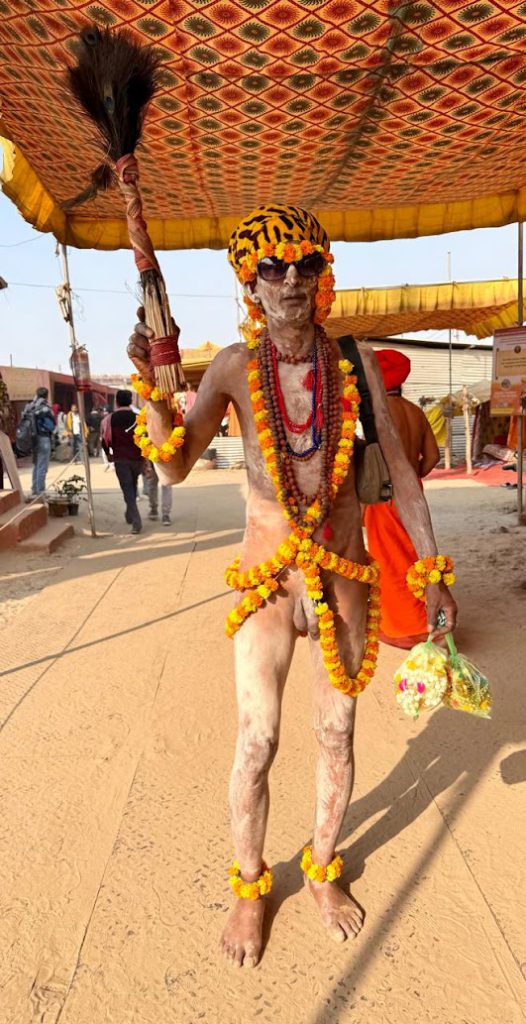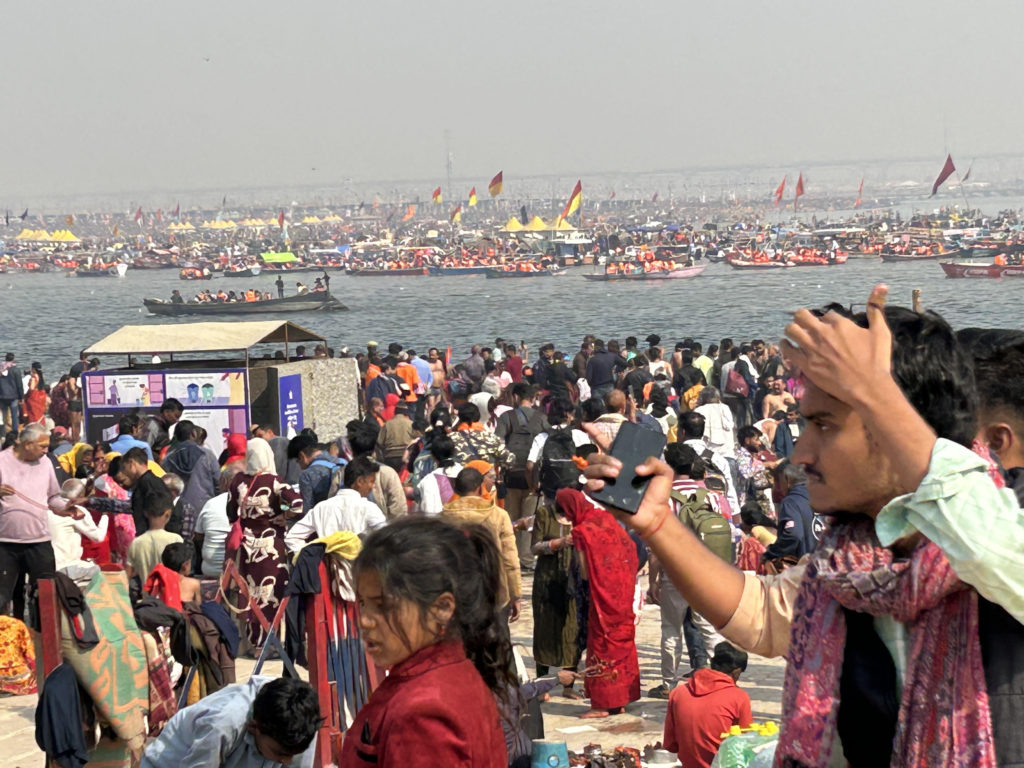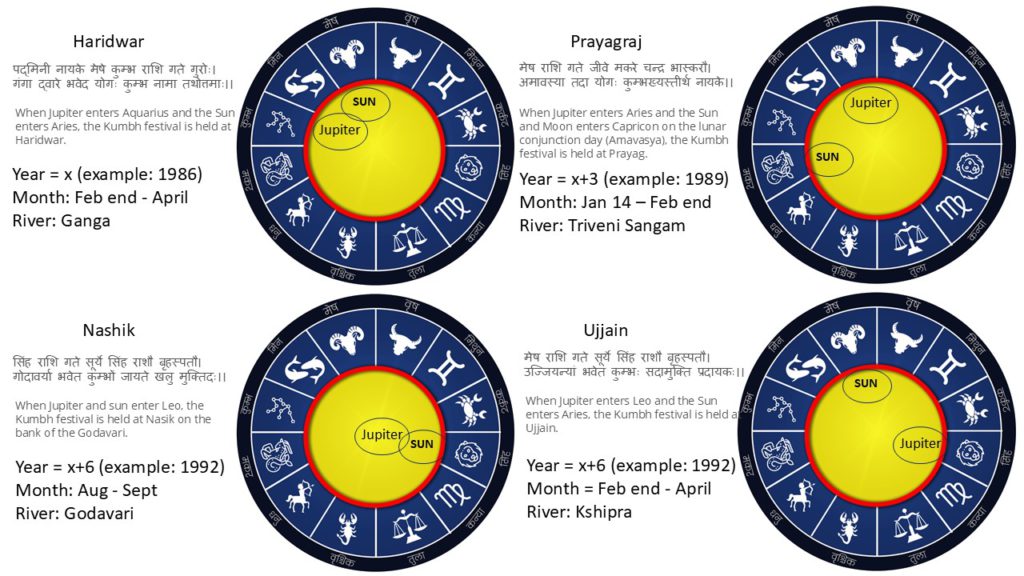(400 million people are expected to gather at the confluence of the Ganga, Yamuna, and Saraswati rivers near the city of Prayagraj for a holy dip from January 13 to February 26, 2025. This 45-day festival is called Kumbh Mela (festival). I will be visiting Kumbh Mela from February 1-5, 2025.)
I returned from Kumbh Mela on February 5, 2025. I found myself paralyzed by the sheer intensity of stories and experiences. I am still overwhelmed, still soaking it in and still struggling for words.
It will take a while for me to peel my mental inner layers and articulate the impact of this experience. Meanwhile, let’s address some common questions about the Kumbh Mela.
Q: What is the significance of the Kumbh Mela celebration?
A: According to Hindu beliefs, taking a ritual bath at the confluence of the Ganga, Yamuna, and Saraswati rivers during Kumbh cleanses one’s sins and offers mukti (liberation from the cycle of reincarnation). Millions gather at Prayagraj driven by this sacred belief.
The festival also draws sadhus (holy men) from their solitary retreats across the vast land of India. Among them are the Naga sadhus, who have performed their own pinda-daan (funeral rites) to symbolically end their worldly existence. For these ascetics, Mother Ganga remains their sole connection, making their reunion every twelve years deeply significant.

The Kumbh Mela serves as a massive spiritual gathering featuring thousands of sermons, devotional meetings between pilgrims and sadhus, religious discourses, mass pujas (worship ceremonies), exchange of views among sadhus, induction of new sadhus, cultural events and book exhibitions. It’s also a time when new aspirants begin their journey into ascetic life through Sanyas (renunciation of worldly attachments).

Q: Is the expected attendance of 400 million people at Maha Kumbh accurate?
A: This question is completely irrelevant for my experience at Maha Kumbh. Anything above million people was already beyond my imagination. But let me provide my understanding of the crowd size based on my observations.
The Kumbh Mela has no formal entry points or invitations. Pilgrims continuously stream into the 30-by-2-kilometer area via roads and railways, day and night. Apparently, independent organizations verified that the previous Ardha Kumbh in 2019 drew between 200 and 220 million people. Better access, higher population and social media awareness are expected to increase this number dramatically. During Basant Panchami this year, the crowd density was so intense that my walking even a few kilometers meant constant physical contact with others. With the festival 70 percent complete, attendance has already exceeded 500 million people. So, do I trust government declared daily numbers? The answer is “yes”, with few caveats.

The government uses drones, CCTV cameras, and other aerial surveillance tools to estimate crowd size. However, the constant movement of pilgrims can lead to double-counting. Most people visit the river, take a dip and leave the area, all in a single day. But, multi-day visitors like myself are inevitably counted multiple times. Additionally, the tent city houses approximately one million permanent residents—including sadhus, workers, and police personnel—who are also repeatedly included in daily counts.
As a completely side note, capacity planning for such a unique and massive event in the world has been of interest to many researchers (1). MIT researchers ((Ramesh Raskar, Nilay Kulkarni and Abhishek Mehta) have also visited and analyzed supply chain in 2019 and 2025. Their analysis has assumed the flow of 400 million people.
Q: What role do planetary alignments play in determining Kumbh Mela dates?
A: The Kumbh Mela has been celebrated for millennia at four sacred locations in India—Haridwar, Prayagraj, Nashik, and Ujjain. The dates are determined by specific zodiacal alignments of Jupiter and the Sun, based on highly developed ancient Indian astronomical calculations. Jupiter completes its zodiacal cycle in approximately 12 years, while the Sun completes its cycle in one year. These orbital periods determine the timing of each Kumbh Mela, as illustrated in the diagram.

Jupiter’s precise orbital period of 11.86 years necessitates a correction in the Kumbh cycle. After six consecutive 12-year cycles, the seventh Kumbh occurs after 11 years—a adjustment similar to the leap year correction in the solar calendar. Such recent correction happened in Haridwar in 2021. (3)
Additionally, Haridwar and Prayagraj uniquely observe the Ardha (half) Kumbh Mela midway between two Purna (complete) Kumbh Melas, occurring every six years.
Q: Why such specific planetary alignments chosen for Kumbh?
A: One theory suggests a connection to the 11-year solar activity cycle. However, the relationship between increased solar activity and the spiritual significance of ritual bathing remains unclear. Moreover, this theory doesn’t explain why the Kumbh occurs at different times across the four locations.
Q: Why were these four specific locations—Haridwar, Prayagraj, Nashik, and Ujjain—chosen for the Kumbh Mela, rather than other cities (such as my hometown Dombivali, or my current city of Canton, Michigan)?
A: The mythology of the Kumbh Mela, as discussed in my previous blog post (4), provides essential context. During the Samudra-Manthan (the churning of the cosmic ocean), the nectar of immortality emerged in a sacred vessel called the Kumbh. fierce battle erupted between the Devas (celestial beings) and Asuras (demons) for possession of this precious nectar. During this cosmic conflict, drops of the divine nectar fell at four sacred sites across India: Haridwar, Prayagraj, Nashik, and Ujjain. The specific reasons—whether astronomical, political, or cultural—for the significance of these four locations remain shrouded in mystery.
Q: Is there special significance to the 144-year cycle of the Maha Kumbh Mela?
A: My limited research has not uncovered historical evidence supporting a special 144-year Maha Kumbh Mela cycle. If we account for the correction of the seventh cycle across all locations, the mathematical interval between major cycles would be 143 years, not 144. There is also no specific planetary alignment mentioned after every 144 years.
One theory suggests a connection to the six-planet alignment visible since late January 2025, an astronomical event that occurs every 175 years. However, determining the historical cycles of such alignments from several millennia ago requires further research. (5)
The next installment will explore the Kumbh Mela’s layout, infrastructure, the Ganga’s water quality, and the available tent facilities for me.
-Nitin Anturkar (February 13, 2025)
Acknowledgment:
(1) The planetary alignment discussion draws from correspondence with Anil Ketkar, an accomplished astrophotographer and college alumnus.
(2) Most photographs featured in my Kumbh blogs are ones I captured personally. However, I’ve also included images shared by friends who accompanied me to the Kumbh Mela.
References:
1. “Capacity Planning for Large Scale People Movement: Models and Application to Ujjain Kumbh Mela,” by Jyotirmoy Dalal, Ananth V. Iyer, Naval Research Logistics, Wiley Online Library, 2021.
2. Sanskrit shlokas (stanzas) describing the planetary positions of Sun and Jupiter are mentioned in the source below.
Mahakumbh Mela – Astrological Aspect
3. Jupiter takes 11.86 years to complete one revolution around all the zodiac signs.
4. https://www.dadhionthetrail.com/2025/01/18/kumbh-mela-preview-self-exploration-part-ii/
5. https://www.bbc.com/future/article/20250117-planetary-parade-what-the-alignment-of-seven-planets-really-means-for-science


Looking forward to the next installment
Amazing information, Nitin.
I’m glad that you could visit Kumbh and take the sacred dip.
Amitabh and I are planning to be there for the last 3 days.
Looking forward to the next one.
Mind boggling info & crowd
management !
Awaiting for next chapter.
400 million people, like almost whole of USA pouring in Prayagraj 😊😊
Waw what a great experience. I feel every one should visit in life time.
https://youtu.be/Xbo6GaRZNBI
Nitin, I had put the astronomy-related information together in a Marathi video. Link above. Note the WYSIWYG nature of the astronomical information. One doesn’t need any external reference to figure out the designated period. A bit of familiarity with the night sky is enough.
Tu si great Ho, Nitin! Very thorough write-up. Thank you for sharing this wisdom with us.
Nice information on Kumbhmela.
Keep it up.
Awaiting eagerly for next blog.
Looking forward to reading about your experience in Mahakumbh!